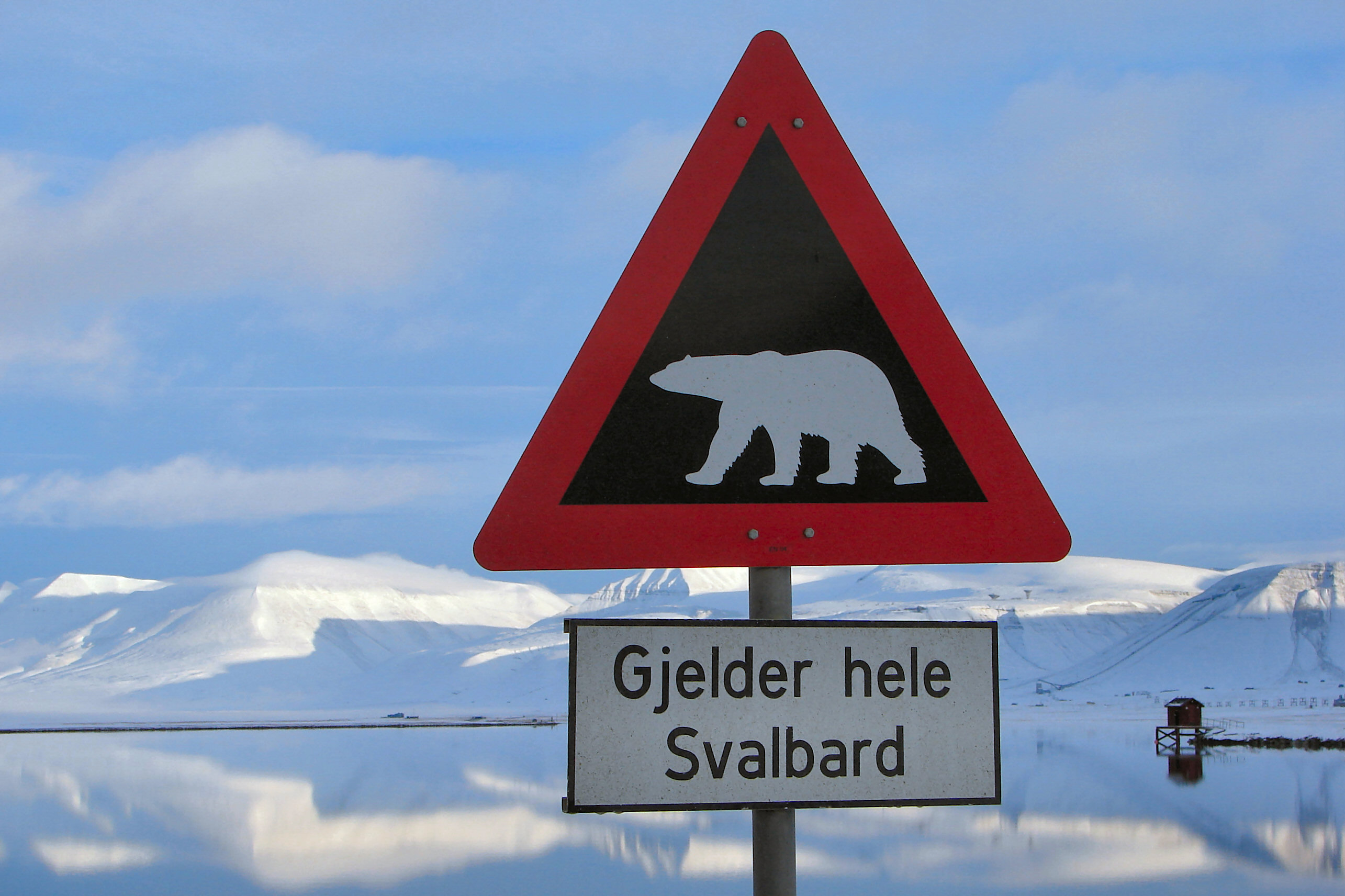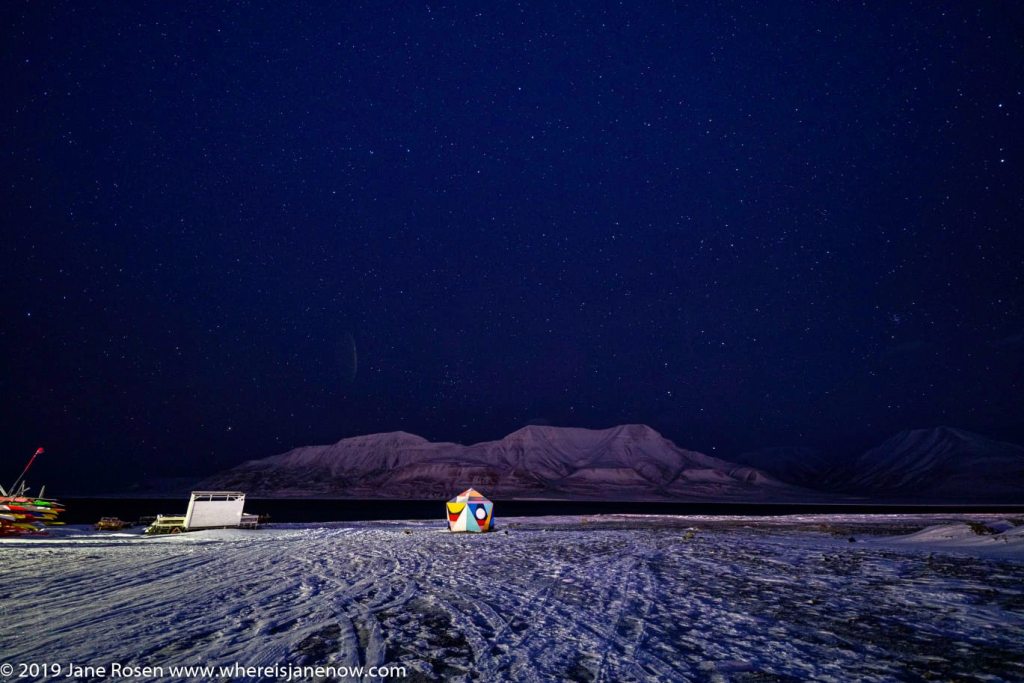Jane’s Guide to Photographing the Northern Lights in Svalbard
Jane’s Guide to Photographing the Northern Lights …
in Svalbard
If you are visiting Svalbard, seeing the northern lights is probably one of the items on your list. After all, it is very far North, so one would think that you have a better chance of seeing the northern lights there. In reality, it’s often too far north, and the action is often frustratingly farther South. Another factor that makes Svalbard a less ideal location is that there’s really nowhere to drive to get to different weather. If you’re in Longyearbyen, there’s roads for maybe 10 km in either direction from town… and that’s it. If it’s cloudy, you can’t drive a while to get away from the clouds. And it is often cloudy, windy, and cold. Also, it is not common to rent a car while there (because there’s really nowhere to go), so you’re likely to be walking to your lights viewing spot. The town has a lot of lights, and there are not a lot of places in the polar bear safe area that you can go to find some dark sky.
If you’re still set on seeing northern lights in Svalbard, there are several factors that do make it a good spot to go.
- It is really far north, so the Kp value doesn’t matter that much. You can see Lights with a Kp 1-2. In fact, higher Kps often mean that your activity is too far south to see!
- It is dark all day in the winter. You can potentially see the Lights 24 hours a day!
- The Kjell Henriksen Observatory is near Longyearbyen and their website has a lot of tools and resources including a sky camera so you can know what’s up in the sky without going out and setting up your camera. (I’m currently watching it, and wishing I could be there!)
- There is an active community of Aurora Spotters on Facebook that you should join!
Safety in Longyearbyen

Don’t go past these signs without polar bear protection!
The threat of polar bears in Svalbard is real; there are more bears than people on the archipelago! For this reason, you need to carry polar bear protection if you are leaving town! This means a rifle and a flare gun. Polar bears like to be by the water, so you’re more likely to encounter them by the shore, but everyone carries a weapon when leaving civilization, even if they’re going towards the mountains. It is possible to rent a rifle at some of the sporting goods stores in town.
There is a commonly circulated map that has the polar bear safe zone highlighted in pink that every hotel has available, and that may also be found on visitsvalbard.com. I edited it a bit to add in some darker spots for watching northern lights, and annotated another river crossing and crossed out a bridge that wasn’t operational when I was in town.
If you have a rental car, getting a gun and driving up or down the road leads you to some dark road with scenic views of the mountains, and if you follow it to the end, you end up at Mine 7 (the operational mine) and the Observatory. (Driving up there can disturb the sensitive instruments, so it’s not the best plan… probably better to stay down by the base of that mountain!)

Other Ways to Get Out Of Town
We’ve covered walking and renting a car, your other option is to book a tour. Fortunately, there is a convenient centralized booking site where many tour operators list their adventures! You can go by bus, boat, snow mobile, or dogsled, for just a few hours or for several days. These trips are lovely, but can be quite expensive, especially for the multiple day trips! You have more tour options in January/February than you do in December (guess when I went!)
Your Camera (and yourself) in the Cold
It is cold in Svalbard. Really cold. So cold that some of your normal expectations about the properties of common everyday objects might be incorrect. Plastic is brittle. Batteries drain REALLY fast. Liquids freeze. Fingers and toes will get frostbite if inadequately protected.
Regarding keeping yourself warm, I have a post about what I wear in Norway and it applies. In Svalbard I always wear ski pants if I’m going to be outside for more than 10 minutes, and glove warmers/boot warmers are essential (at least for me). Glove/mittens are nice too, but make sure to get ones that are designed for less than -20C and wind/waterproof. Make sure you have a windbreaking layer because it gets VERY windy in Svalbard. There were days when we couldn’t go outside because whiteout and gale force winds.
Your camera doesn’t have the benefits of wearing a toasty snow suit, and your batteries will drain rapidly. My poor cell phone (Pixel 2) really did not like the cold, and would shut off after less than 3 minutes in my hand. My Sony Alpha IIIR fared better than expected, and actually held battery charge for more than 2 hours of walking around town trying to find good dark spots for northern lights photography. When I came in, it was at about 80%!
Also remember that your cold camera will cause humidity to condense when you bring it indoors. You might want to consider bringing a seal-able plastic bag out with you, and put your camera in there before coming in. This time around, I didn’t do that and my camera was OK, probably because it was quite dry inside.
This was my first trip with my Sigma ART 14mm F1.8 lens and I absolutely loved shooting with it. It had no issues in the cold.


In Conclusion
Svalbard is an amazing community that is fascinating to visit! If you happen to be there in the dark winter, hunting northern lights is definitely a fun thing to do, but probably not the best idea to travel there specifically for Northern Lights viewing… go instead for the culture, the history, the dog sledding, the hiking, and all the fascinating tours and expeditions that start there. I look back fondly on my time in Svalbard and hope to return there someday!




Some beautiful photos! I’d love to see the Northern Lights, let alone photograph them 🙂
It’s amazing to see them! My recommendation on where to go to see them best is northern Norway!
Wow that’s a very useful guide..watching northern lights is in my bucketlist .thanks for sharing this useful guide